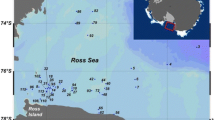Abstract
Mesozooplankton (<5 mm) collected by stratified oblique tows with a 1-m2 MOCNESS was examined at four stations in the Arabian Sea, with special reference to the bathypelagic zone. The profiles commenced about 20 m above bottom, at 4430 m as a maximum depth. The highest mesozooplankton biomass concentrations (wet weight per cubic meter) were obtained from the surface layer during night. A secondary maximum was situated between 150 and 450 m, with maximum concentrations at daytime. This layer coincided with the daytime residence depth of the deep scattering layer. The standing crop of the mesozooplankton in the upper 1000 m was highest at station WAST at 16°N; 60°E (ca. 47 000 mg m−2); station CAST at 14°N; 65°E ranked second (ca. 22 500 mg m−2), followed by station SAST at 10°N; 65°E (11 420 mg m−2). The differences can be related to different productivity regimes at the sea surface generated by the Findlater Jet during the SW monsoon. The differences in surface production were also reflected below 1000 m depth, in the bathypelagic zone, with mesozooplankton wet weights of 5330 mg m−2 at WAST, 3210 mg m−2 at CAST, 3390 mg m−2 at EAST (15°N; 65°E) and 2690 mg m−2 at SAST. The decrease of mesozooplankton concentration with depth in the oxygen minimum zone (OMZ) was stronger than in comparable depths of open-ocean areas where an OMZ is absent. Among the discriminated four size classes of mesozooplankton, the largest fraction (2 to 5 mm) indicated a biomass peak at 1200 m depth, which coincided with the lower boundary layer of the OMZ. The rate of decrease of mesozooplankton biomass with depth in the bathypelagic zone was statistically similar between the sites, even though the absolute zooplankton biomass at the sites was different. There is no evidence that the presumed lower carbon degradation rates in the OMZ of the Arabian Sea caused a larger standing crop and less of a decrease in biomass with depth in the bathypelagic zone in comparison to other seas.
Similar content being viewed by others
Author information
Authors and Affiliations
Additional information
Received: 16 May 1997 / Accepted: 5 June 1997
Rights and permissions
About this article
Cite this article
Koppelmann, R., Weikert, H. Deep Arabian Sea mesozooplankton distribution. Intermonsoon, October 1995. Marine Biology 129, 549–560 (1997). https://doi.org/10.1007/s002270050196
Issue Date:
DOI: https://doi.org/10.1007/s002270050196




